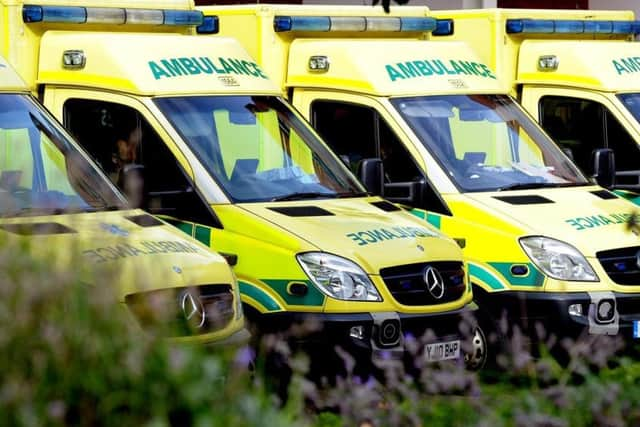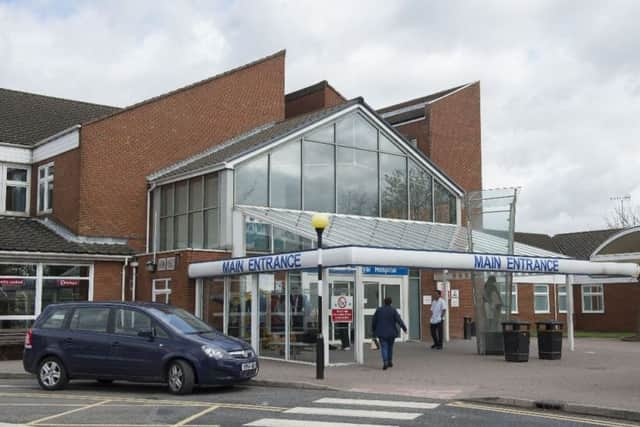‘Hundreds’ of patients left ‘waiting up to an hour’ in ambulances outside Chesterfield Royal Hospital
and live on Freeview channel 276
Unison said the delays risk the safety of patients and are a ‘terrible waste’ of ambulance crews’ skills.
Ambulances took 4,646 patients to emergency departments at the Royal between December 3 and February 3, according to NHS Digital data.
Advertisement
Hide AdAdvertisement
Hide AdOne in 10 waited between 30 and 60 minutes before A&E staff were able to take over from paramedics, and 22 arrivals ‘waited for more than an hour’.


Despite the NHS saying a delay of just 15 minutes is a potential threat to life, 21 patients waited up to an hour in a single day when the
problem was at its most severe.
But the overall number of delays at Chesterfield Royal Hospital has dropped since 2017-18.
Over the same period last winter, 953 patients waited in ambulances for 30 minutes or more, 47 per cent more than this year.


Advertisement
Hide AdAdvertisement
Hide AdColm Porter, Unison’s national ambulance officer, said: “Handover delays are a stark illustration of the extreme pressure on the NHS caused by years of chronic underfunding.
“Not only are patients put at risk with lengthy waits to get into A&E, but there are also fewer ambulances available to respond to emergencies.
“Ambulance staff are stuck in hospitals when they should be out responding to life-or-death 999 calls.
“This is a terrible waste of their skills and the stress it causes can soon takes its toll on their health.”
Advertisement
Hide AdAdvertisement
Hide AdBut the Chesterfield Royal Hospital NHS Foundation Trust maintain they are ‘frequently one of the best performing teams in the country’.
A spokesman for the Royal said: “Around 80,000 patients a year come through the doors of our Emergency Department and we have a good record for seeing, treating, admitting or discharging people within the national four-hour standard.
“When a patient is brought to hospital by ambulance the target is set at a 15-minute handover.
“It means our patients receive the right care, in the right place at the right time and ensures our ambulance service colleagues can go to their next call swiftly.
Advertisement
Hide AdAdvertisement
Hide Ad“It’s why the ED team at the Royal, in partnership with East Midlands Ambulance Service, has worked incredibly hard to improve handover times. “They are already five minutes faster than this time last year, and at the moment 74 per cent of ambulance patients are ‘handed over’ to the care of ED within the 15 minute time-frame.
“This often puts the Royal in the top three for its performance across East Midlands’ hospitals.”
Last year the hospital unveiled a £3 million ED refurbishment that includes a purpose-built ambulance area outside.
Crews bring their patients into a ‘pit-stop’ – a clinical assessment area just inside the front doors where senior medical or nursing team members review a patient and admit them into the department.
Advertisement
Hide AdAdvertisement
Hide AdThe hospital spokesman added: “From December 3 2018 to February 3 2019 we recorded 12 instances where patients were cared for by the ambulance crew that brought them into hospital for more than one hour.
“This can occasionally happen at times when there is extreme demand – high numbers of emergency admissions arriving by ambulance all at once, ED teams working on several critical patients in resus, the hospital wards at full capacity and patients waiting in ED to be admitted to other wards and departments.
“While patients are not held in the back of ambulances and they are cared for by a healthcare professional, we know that even for a small number of patients it is not the high-quality care we strive to deliver every day and that we would want all our patients to experience.”
NHS bosses have stressed that A&Es should always accept handover of patients within 15 minutes of arrival by ambulance.
Advertisement
Hide AdAdvertisement
Hide AdAn NHS spokesman said: “Thanks to the hard work of ambulance and hospitals more people have benefited from a timely handover this year, despite a significant increase in people requiring care.
“We remain committed to further reducing delayed handovers, so that ambulance crews are able to get back out on the road and providing care to patients sooner.”
Across England, nearly 100,000 people waited for 30 minutes or more between December and February - one in 10 arrivals.
Chesterfield Royal Hospital said they would ‘continue to do our upmost to reduce the likelihood of handover delays’ where they can ‘have an impact’.
Advertisement
Hide AdAdvertisement
Hide AdThis woild involve improving how staff ‘flow’ patients in all areas of the hospital, from the moment they are admitted through to when they are ready to go home.
The Royal spokesman added: “Improving discharge from hospital is just as important as improving access.
“Our discharge lounge, patient transport service, pharmacy take home medicines and social service or community hospital support all contribute to our ability to take patients as soon as they arrive at ED, meeting handover timescales, although more importantly providing first-class care and treatment for our patients.”